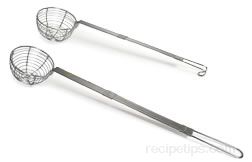
Bird's Nest Basket For Deep Frying |
|
| The process of "dry" cooking food totally covered in hot cooking fat or oil. This process produces evenly cooked food with a golden, crisp surface on the outside. While the moisture on the inside of the food which acts to repel the oil is heated and boils, the food steam cooks, making it moist and tender. The temperature of the oil is important in order to achieve the best results. If the oil is not hot enough, the food cooks too long and may absorb some of the oil or it may not be cooked in the proper amount of time. If the oil is too hot the oil may penetrate the food and become absorbed into the food. Also, the food may burn as the water is forced out of the food, making it dry and oily. The best temperature for the oil is 350ºF to 375ºF, depending on the temperature of the food being fried and the amount being cooked. Some of the foods commonly cooked by deep frying include, pastries such as doughnuts, fish, shellfish, vegetables, meat, and poultry.
A few Deep Frying tips that may assist with the process include:
Always consider the safety aspects of deep frying: keeping small children well away from the hot oil; wearing protective mitts; using utensils built for deep frying; keeping hot oils away from other heat sources or burners; placing fryers only on flat level surfaces large enough so the fryer cannot tip or fall off spilling the oil; and never leaving the fryer unattended by an adult. If the oil begins to smoke, turn off the appliance immediately.
Cold foods should be warmed slightly before frying so the outside of the food does not burn prior to the inside being fully cooked.
Choose or prepare foods for frying that are similar in size to keep the cooking time the same for all of the foods.
Keep oils clean and light colored since darker oils indicate they have had repetitive use and may impart a poor flavor into the foods being fried. Fresh oils require a minute or two increase for the cooking time.
Consider all options for choosing types of fry oils possibly selecting an alternative type of oil that serves to improve health benefits such as replacing oils containing trans fat with oils containing non-trans fats.
For breaded foods covered with a dry breading, use some type of food wash such as an egg wash to strengthen the bond between the breading and the food to keep it attached as the food fries.
For breaded foods covered with a wet breading, add cornmeal or flour to improve the bond to the food.
Keep a fire extinguisher available that is made to extinguish grease fires, in case the flammable oil catches fire.
If the deep fryer is not equipped with a temperature guage, use a deep-fry thermometer to watch and also control the temperature of the cooking oil.
If the deep fryer does not have a removable fry basket, use a long-handled slotted metal spoon or a utensil made for deep frying to place and remove food in the hot cooking oil.
Never use a fork to place food into a fryer or to remove it from the fryer, as the sharp points of the fork puncture the food and will allow oil to enter.
After cooking, place the foods removed from the fryer on several layers of paper towels to allow excess oils to be absorbed by the toweling.
If the cooking oil is to be stored after use, allow it to cool for 30 minutes, strain it through a fine mesh screen or cheesecloth to remove excess particles, and then refrigerate the oil. The used cooking oil must be refrigerated to keep it from becoming rancid or growing harmful bacteria. |
|

